Cape Coast (26-28 December)
George (?) from Ellis’s offered to go to the village with us to sort out a car. He took us to the chief’s house, where after five minutes a driver appeared and wanted ¢200,000 (£11), we walked away to the tro-tro station.
A shared taxi to Agona is apparently the standard ¢5000 each but there were no cars waiting so we hung around at the station. Eventually a taxi turned up empty but wasn’t running as a shared taxi, George had called him. We agreed ¢60,000.
At Agona there were no tro-tros to Cape Coast so we had to go back to Takoradi. We had lunch at a chop shop, rice and stew with chicken for ¢7000 (£0.40) then returned to the tro-tro station but it was the wrong one. We walked across town, which was full of kids and young men in multi-coloured outfits with masks. There was a carnival happening in the street outside the tro-tro station. We bought tickets for the next tro-tro, ¢12,000 because it was a “big car” with four cramped seats across (it’s ¢14,000 in a smaller van with three seats across).
I had a sleepy and uncomfortable journey to Cape Coast, where we were dropped near a market. Due to a lack of street signs it was tricky to work out where we were and taxi drivers kept hassling us. I eventually figured it out and we made our way to the Red Cross Hostel. This is probably the cheapest place to stay in Ghana, ¢80,000 for a self-contained room with three single beds! It’s quiet and clean, in the Victorian part of town.
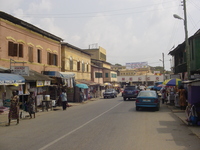
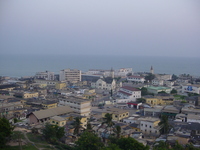
We walked down to Heritage House (formerly Government House) and had a beautifully cold beer then walked down to the Castle Restaurant to check prices there, we’d arranged to meet Leo there the next day.
For dinner we went to the Cape Café, which is recommended in the guidebook. It seems to have moved and left everything that was good about it behind. It’s now in a large, hot and poorly lit building. The only working lights were in the kitchen, we had to eat by the light of the TV and the fridge. Prices had increased, most of the menu wasn’t available and what was available wasn’t great. Marebec was still hungover and had fried rice and chicken, Dave had some greasy spring rolls and I had a spicy chicken kebab with yam balls for ¢50,000.
We went back to Heritage House for another beer and discussed plans for our remaining time. I’d earlier phoned to book a single and a double at the Kokomlemle Guesthouse for the 2nd and 3rd or January, Dave phoned the Xofa Eco-Village by Lake Volta to book for New Year.
The next morning I was up early again, had a shower and did my washing then sat in the shade reading while I waited for the others. The plan had been to go to the castle early so we’d have plenty of time to look around before meeting Leo. In the end I grabbed a rushed breakfast of nuts and Coke because it was getting quite late by the time Marebec was ready.
Entrance to Cape Coast castle was only ¢40,000 (£2.20) for us because we’re volunteers, I wish the Nigerian government would do something similar. We looked around the (very good) museum for a while then the guide fetched us for the tour. The tour was good, taking in the male slave dungeon, the former tunnel from the dungeon to the exit, the female dungeon and the “door of no return” (labelled the “door of return” on the outside).
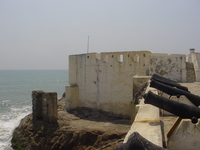
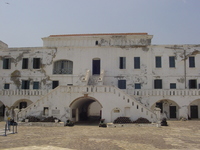
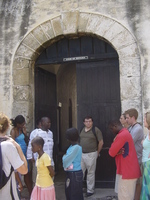
(In the left-hand picture the male dungeon is behind the wall at the centre, it originally had its own exit to the sea where the pillars (once an arch) stand.)
It was difficult to get any idea of what it was like back in the days of the slave trade, the guide was a little bit too breezy with his insistence that it should be left to God to judge those involved. There’s a little plaque by the dungeon put up by the local chiefs to apologise for the part their predecessors played in selling people into slavery.
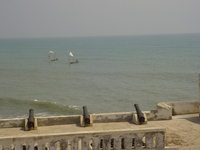
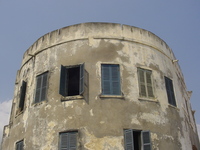
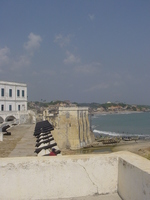
We met Leo, Sarah and Pat and had lunch at the Castle Restaurant then went for a bit of a wander around town before another beer at Heritage House. After Leo, Sarah and Pat headed back to their hotel in Elmina we visited the two smaller forts in Cape Coast: Fort William (once a lighthouse, now housing wireless internet equipment) and Fort Victoria (derelict and inhabited by a high-school student called Joe).
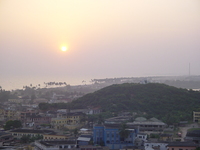
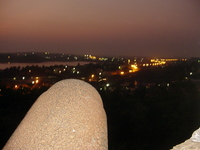
![[Nigeria]](/media/Flags/NGflagSmall.png)